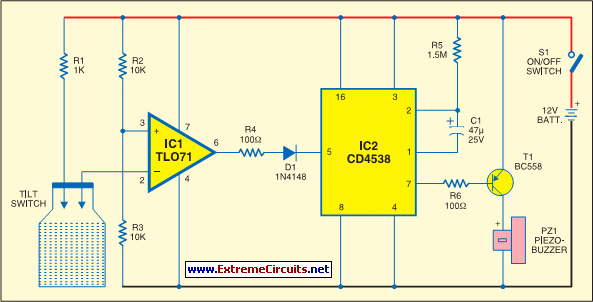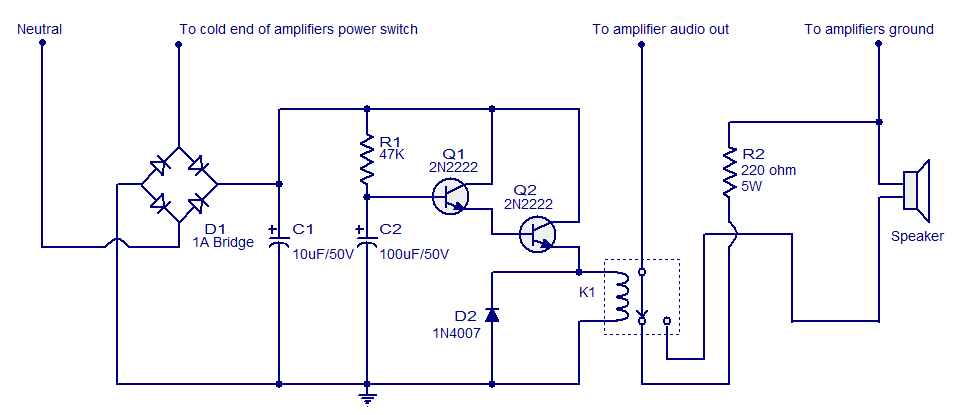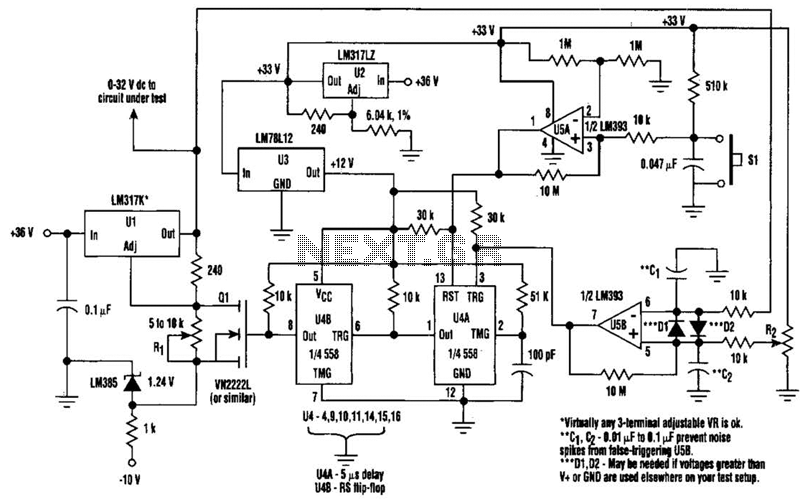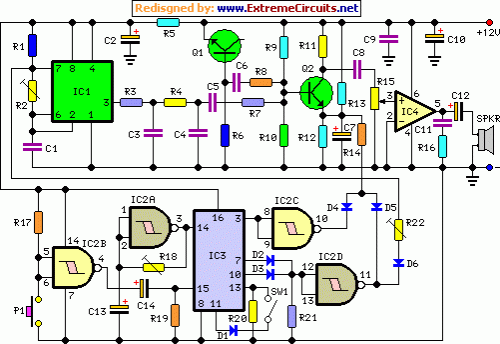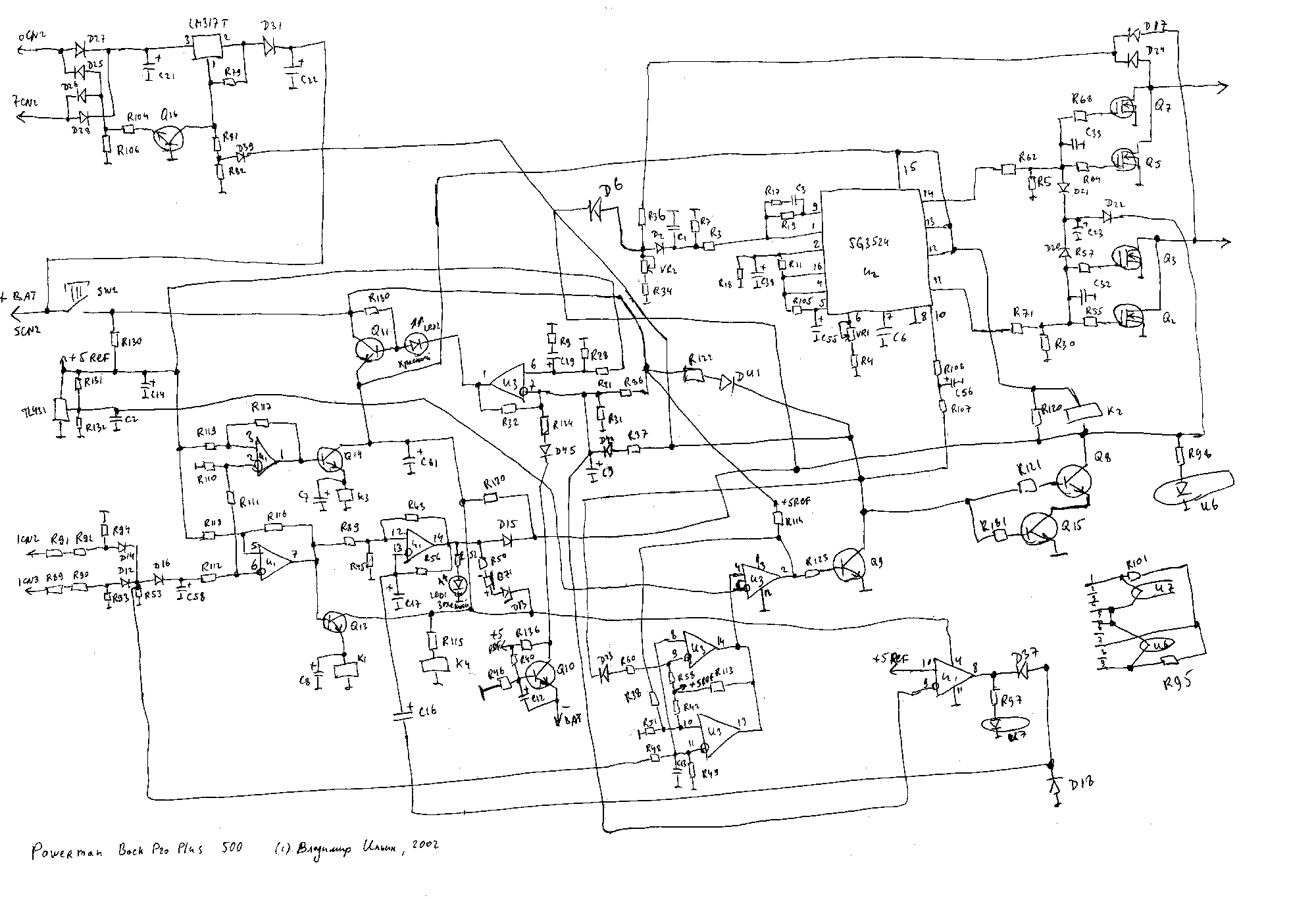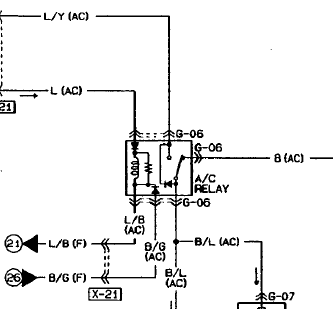
Two-channel speaker protection schematic
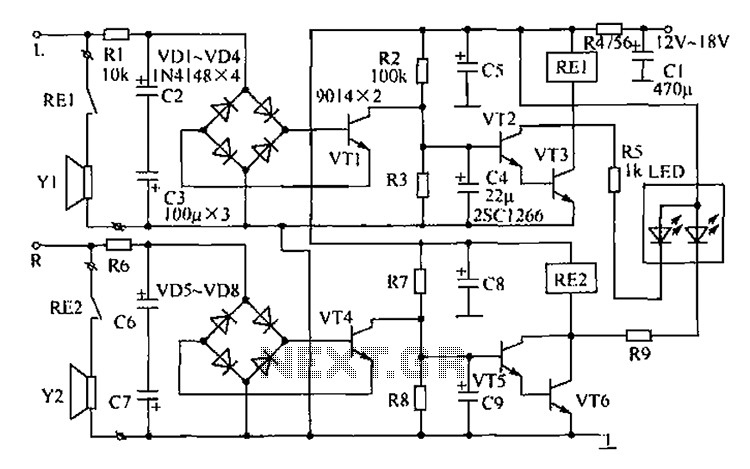
The speaker protection circuitry is designed for independent operation of the left and right channels. The left channel is exemplified by components R2, C4, and the VT2, VT3 configuration, which includes a start delay circuit to prevent power surges from damaging the speakers. For component selection, a high-brightness, two-color LED (µ3mm) is recommended. Due to the varying LED current, the values of resistors R5 and R9 may be adjusted accordingly. Additionally, the LED and current limiting resistors R5 and R9 are connected in parallel with relays RE1 and RE2, which helps to suppress voltage spikes and prevent breakdowns in transistors VT2, VT3, VT5, and VT6. Capacitors C4 and C9 should preferably be low-leakage tantalum types.
The speaker protection circuit is a critical component in audio systems, ensuring that speakers are shielded from potential damage caused by power surges or transients. The independent operation of the left and right channels allows for individual protection mechanisms, which is particularly beneficial in stereo setups.
The use of resistors R2 and C4 in conjunction with transistors VT2 and VT3 forms a delay circuit that effectively mitigates the risk of speaker damage during power-up. This delay ensures that the speakers remain disconnected from the power source until the circuit stabilizes, thus preventing any sudden inrush of current that could lead to speaker failure.
The choice of a high-brightness, two-color LED (µ3mm) serves both an aesthetic and functional purpose. The LED provides visual feedback regarding the circuit's status, indicating whether the system is operational. The adjustment of resistors R5 and R9 is crucial, as these components regulate the current flowing through the LED, ensuring it operates within its safe limits while also allowing for brightness variation.
The parallel configuration of the LED and the current limiting resistors with relays RE1 and RE2 is essential for protecting the circuit from voltage spikes. When the relays engage, they provide a pathway for the current, while simultaneously limiting the voltage that reaches the transistors. This configuration minimizes the risk of breakdown in critical components, such as VT2, VT3, VT5, and VT6, which are integral to the protection mechanism.
Selecting low-leakage tantalum capacitors for C4 and C9 is advisable due to their superior performance in maintaining stability and reliability in the circuit. These capacitors are less prone to leakage current, which can compromise the functionality of the protection circuit. Their use enhances the overall robustness of the speaker protection circuitry, ensuring that it operates effectively over time.
In summary, the speaker protection circuitry incorporates a well-designed arrangement of components that work together to safeguard speakers from power surges. The careful selection of components, along with the implementation of a delay circuit and protective measures against voltage spikes, contributes to the durability and reliability of audio systems. As shown for the speaker protection circuitry. It is designed for the left and right channels operate independently. The figure (to the left channel as an example) of R2, C4 an d VT2, VT3 composition start delay circuit to prevent power current shock speaker. Component selection: LED high brightness can be used µ3mm two-color LED. Since the LED current big and small, R5, R9 parameters may be slightly adjusted. At the same time, LED and current limiting resistor R5, R9 because in parallel relay RE1, RE2 ends, but also restrain the anti-peak voltage to prevent breakdown VT2, VT3 and VT5, VT6. C4, C9 best selection of low-leakage tantalum capacitors.
The speaker protection circuit is a critical component in audio systems, ensuring that speakers are shielded from potential damage caused by power surges or transients. The independent operation of the left and right channels allows for individual protection mechanisms, which is particularly beneficial in stereo setups.
The use of resistors R2 and C4 in conjunction with transistors VT2 and VT3 forms a delay circuit that effectively mitigates the risk of speaker damage during power-up. This delay ensures that the speakers remain disconnected from the power source until the circuit stabilizes, thus preventing any sudden inrush of current that could lead to speaker failure.
The choice of a high-brightness, two-color LED (µ3mm) serves both an aesthetic and functional purpose. The LED provides visual feedback regarding the circuit's status, indicating whether the system is operational. The adjustment of resistors R5 and R9 is crucial, as these components regulate the current flowing through the LED, ensuring it operates within its safe limits while also allowing for brightness variation.
The parallel configuration of the LED and the current limiting resistors with relays RE1 and RE2 is essential for protecting the circuit from voltage spikes. When the relays engage, they provide a pathway for the current, while simultaneously limiting the voltage that reaches the transistors. This configuration minimizes the risk of breakdown in critical components, such as VT2, VT3, VT5, and VT6, which are integral to the protection mechanism.
Selecting low-leakage tantalum capacitors for C4 and C9 is advisable due to their superior performance in maintaining stability and reliability in the circuit. These capacitors are less prone to leakage current, which can compromise the functionality of the protection circuit. Their use enhances the overall robustness of the speaker protection circuitry, ensuring that it operates effectively over time.
In summary, the speaker protection circuitry incorporates a well-designed arrangement of components that work together to safeguard speakers from power surges. The careful selection of components, along with the implementation of a delay circuit and protective measures against voltage spikes, contributes to the durability and reliability of audio systems. As shown for the speaker protection circuitry. It is designed for the left and right channels operate independently. The figure (to the left channel as an example) of R2, C4 an d VT2, VT3 composition start delay circuit to prevent power current shock speaker. Component selection: LED high brightness can be used µ3mm two-color LED. Since the LED current big and small, R5, R9 parameters may be slightly adjusted. At the same time, LED and current limiting resistor R5, R9 because in parallel relay RE1, RE2 ends, but also restrain the anti-peak voltage to prevent breakdown VT2, VT3 and VT5, VT6. C4, C9 best selection of low-leakage tantalum capacitors.
